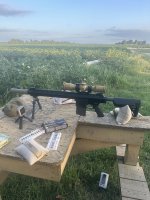Totally agree. 100%. Shell out the money for a LMT, SR25, or something with a long standing history of reliability and be done with it. A lot of guys throw together cheap small frame 5.56 builds with aero and ballistic advantage parts and they run so it breeds the idea they can do the same thing on a large frame gas gun. Different animal.
You can also get into an ArmaLite for anywhere from $1200-$2000, and those guns are built right. I look at a lot of the conversations about trying to penny-pinch and cut corners getting into a large frame and wonder if the buyers have ever looked at the price of ammo that you shoot through large frames, or have considered that most scopes will break from that triple-spike acceleration from firing, bolt impact with the breech, and carrier impact with the extension. AR-10s are really hard on optics.
If it’s a stretch for a buyer to think that the baseline rifle is in the $1500-$2000 range, then you’re going to be hit with the reality of optics, mounts, case, mags, and ammo requiring much more than the base rifle points.
I think the allure is that you can piece one together like an AR-15 to offset those costs a bit up-front, but since the large frame world is only diversifying even more and most of the companies don’t have a nailed-down technical data set, it just doesn’t work out like that. If you did have the tools to assemble an AR-10 properly, were able to measure the tri-bore IDs of the carrier, and press-fit the gas block onto the journal, you’re already well into money that could have gone to a proven rifle.
How many Aero or 80% or whatever parts-bash large frames out there have pressed-fit gas blocks or known tri-bore dims? How many of them have cheap MIM’d small parts that crumble and come loose under a round count? How many carrier rails smash into the RET threads? How many of them clip the gas tube flange on the carrier key or have the incorrect gas tube length, wondering why they can’t get the gun to cycle?
Even if I machined my own set of large frame armorer’s gauges, to which data package would I follow? There’s no way outside of a single company to measure carrier bore dims, bolts, gas tube height location, carrier rail lengths, receiver dims, extension tunnel ID, extension OD/length/etc.
This is why if you do go a semi-DIY route, you use common OEM receivers, BCG, extension, and then spin a pipe for it. I haven’t even talked about RETs and buffer lengths.




